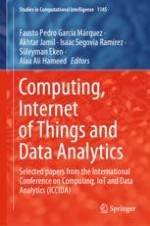2024 | Buch
Computing, Internet of Things and Data Analytics
Selected papers from the International Conference on Computing, IoT and Data Analytics (ICCIDA)
herausgegeben von: Fausto Pedro García Márquez, Akhtar Jamil, Isaac Segovia Ramirez, Süleyman Eken, Alaa Ali Hameed
Verlag: Springer Nature Switzerland
Buchreihe : Studies in Computational Intelligence
